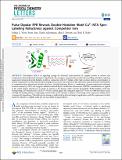Pulse dipolar EPR reveals double-histidine motif CuII-NTA spin-labelling robustness against competitor ions
Date
25/03/2021Grant ID
RPG-2018-397
099149/Z/12/Z
BB/R013780/1
RPG-2017-214
Metadata
Show full item recordAbstract
Pulse-dipolar EPR is an appealing strategy for structural characterization of complex systems in solution that complements other biophysical techniques. Significantly, the emergence of genetically encoded self-assembling spin labels exploiting exogenously introduced double-histidine motifs in conjunction with CuII-chelates offers high precision distance determination in systems nonpermissive to thiol-directed spin labeling. However, the noncovalency of this interaction exposes potential vulnerabilities to competition from adventitious divalent metal ions, and pH sensitivity. Herein, a combination of room-temperature isothermal titration calorimetry (ITC) and cryogenic relaxation-induced dipolar modulation enhancement (RIDME) measurements are applied to the model protein Streptococcus sp. group G. protein G, B1 domain (GB1). Results demonstrate double-histidine motif spin labeling using CuII-nitrilotriacetic acid (CuII–NTA) is robust against the competitor ligand ZnII–NTA at >1000-fold molar excess, and high nM binding affinity is surprisingly retained under acidic and basic conditions even though room temperature affinity shows a stronger pH dependence. This indicates the strategy is well-suited for diverse biological applications, with the requirement of other metal ion cofactors or slightly acidic pH not necessarily being prohibitive.
Citation
Wort , J , Arya , S , Ackermann , K , Stewart , A J & Bode , B E 2021 , ' Pulse dipolar EPR reveals double-histidine motif Cu II -NTA spin-labelling robustness against competitor ions ' , Journal of Physical Chemistry Letters , vol. 12 , no. 11 , pp. 2815-2819 . https://doi.org/10.1021/acs.jpclett.1c00211
Publication
Journal of Physical Chemistry Letters
Status
Peer reviewed
ISSN
1948-7185Type
Journal article
Description
Funding: JLW is supported by the BBSRC DTP Eastbio. We thank the Leverhulme Trust for support (RPG-2018-397). This work was supported by equipment funding through the Wellcome Trust (099149/Z/12/Z) and BBSRC (BB/R013780/1). We gratefully acknowledge ISSF support to the University of St Andrews from the Wellcome Trust.Collections
Items in the St Andrews Research Repository are protected by copyright, with all rights reserved, unless otherwise indicated.

